Retaining walls don’t just hold back soil; they also keep your landscaping stable, prevent erosion, and manage water runoff, especially on sloped or uneven ground. But like any hardworking feature of your home, they’re not going to last forever. The lifespan of a retaining wall depends on what it’s made of, how well it was built, and how it’s cared for over time. A little maintenance can go a long way, but neglect can turn small issues into expensive repairs or total failure. Here’s everything you need to know to keep your retaining wall standing strong:
What’s the Lifespan of Different Retaining Wall Materials?

The material of your retaining wall plays a big role in how long it’ll stand strong. Some materials are naturally more durable, while others need a bit more care to go the distance.
Timber Sleeper Retaining Walls Lifespan
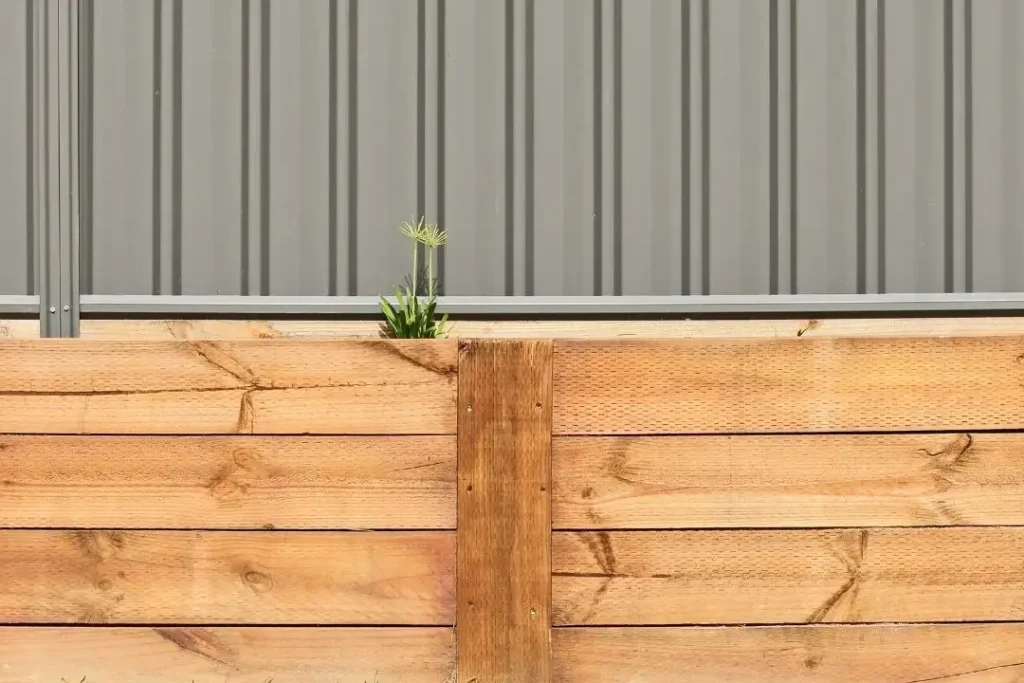
10–20 years
Affordable and quick to install, but vulnerable to rot, termites, and water damage if not properly treated and a proper drainage solution installed.
Concrete Sleeper Retaining Walls Lifespan

25–40+ years
Long-lasting and resistant to pests and rot. Good drainage is still key to preventing cracks from pressure build-up.
Concrete Block Retaining Walls Lifespan
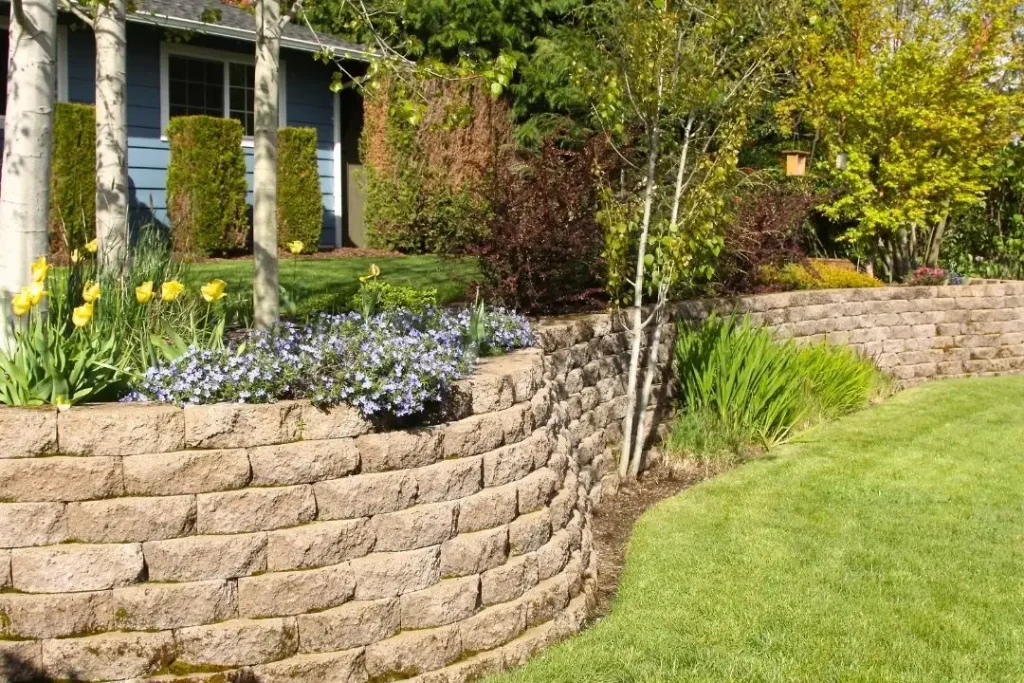
40–50+ years
Strong and sturdy when properly engineered and drained. Mortar joints may need repointing over time to maintain strength.
Sandstone Block Retaining Walls Lifespan
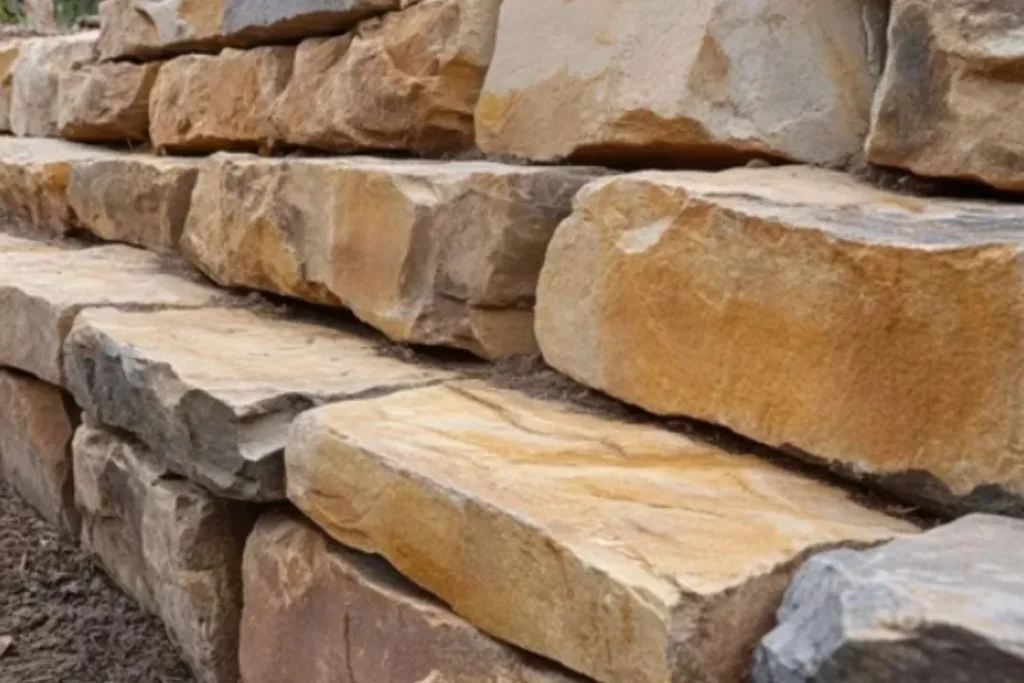
30+ years
Natural and beautiful, these walls can last for decades with the right support and drainage. Without it, shifting soil can shorten their lifespan.
Gabion Retaining Walls Lifespan

50+ years
Highly durable with minimal maintenance, though the steel cages need to be protected against rust to stay in top shape.
No matter the material, things like soil pressure, water exposure, UV damage, and how well the wall was installed all affect how long it’ll last. Regular maintenance and good drainage can help stretch those numbers.
Maintenance Requirements for Each Retaining Wall Type
Timber Sleeper Maintenance
Timber sleeper walls need regular inspections to catch early signs of rot, warping, or termite activity, especially in Queensland’s humid climate. Applying a timber preservative or sealant every few years helps protect against moisture and pests, keeping the sleepers strong and intact. If you spot any damaged or weakened sleepers or posts, it’s best to remedy the wall early before it compromises the entire structure. For extra peace of mind, you can also check out the QBCC’s guide to protecting your property against termites for tips on prevention and treatment.
Concrete Sleeper Maintenance
Concrete sleepers are low-maintenance but still need occasional care. The most important task is keeping weep holes clear to allow water to drain properly, reducing pressure behind the wall. Hairline cracks or signs of movement should be addressed quickly before they expand. And while cleaning is important, skip the high-pressure washer. Abrasive cleaning can strip protective coatings and lead to faster wear.
Concrete Block Maintenance
Concrete block walls are durable, but the mortar between blocks can break down over time. Check the mortar joints regularly and repoint them if they start to crumble. Cleaning off algae or stains is also important to maintain appearance and prevent slippery surfaces. Keep an eye out for cracks or bulging, which could signal structural movement that needs professional attention.
Sandstone Block Maintenance
Sandstone walls bring a natural beauty to your landscape but require some upkeep. Monitor the wall for shifting stones and re-level them if they move out of place. Applying a stone sealant, especially in wetter areas, can help preserve the surface and prevent moisture damage. As always, ensure drainage is working properly to avoid erosion under the base.
Gabion Maintenance
Gabion walls are tough but not entirely maintenance-free. Inspect the steel cages periodically for rust or corrosion, especially in coastal areas where salt air accelerates wear. If any wires become loose or damaged, they’ll need to be tightened or replaced to maintain the wall’s integrity. Also, check for settlement or erosion around the base, which could affect stability over time.

Signs Your Retaining Wall May Be Failing
Cracking or Bulging
Cracks in concrete, mortar joints, or between blocks are one of the first warning signs that something isn’t right. Bulging sections, where the wall starts to push outward, are a more serious sign that the structure is struggling to hold back the soil.
Water Leaking or Pooling Behind the Wall
Water leaking through gaps or pooling behind the wall means the drainage system isn’t working properly. This added moisture builds pressure behind the wall, making it more likely to crack, tilt, or collapse over time.
Rotting Timber
For timber retaining walls, rotting sleepers are a common issue. If you notice the timber is soft, discoloured, or crumbling, it’s a sign of moisture damage or termite activity. Without timely repairs, rotting timber can weaken the entire wall.
Tilting or Leaning
If your wall starts to tilt or lean, it’s usually due to shifting soil, poor construction, or water pressure building up behind it. A leaning wall often means the foundation has been compromised and needs urgent attention.
Loose Stones or Panels
In stone or panel retaining walls, loose or shifting sections suggest that the wall’s stability is weakening. These gaps can grow over time, making the structure unsafe.
Soil Washing Out Behind or Under the Wall
If you notice soil washing out from behind or beneath the wall, it means the wall is failing to hold back the earth. This can lead to uneven ground, erosion, or a complete collapse if not addressed quickly.
When Should I Replace My Retaining Wall Instead of Repairing It?
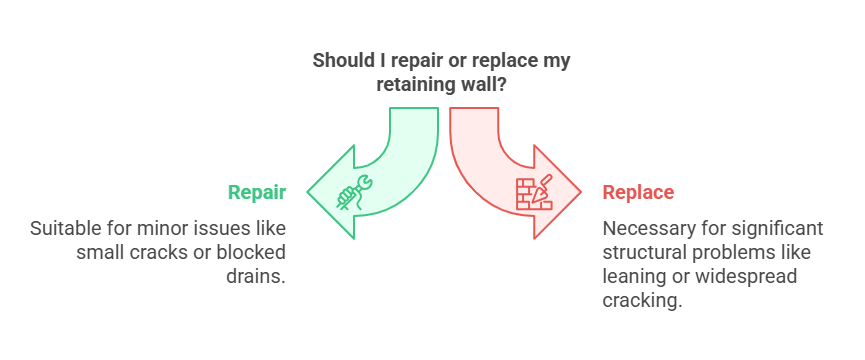
Not every issue with a retaining wall means it’s time to tear the whole thing down. In many cases, small problems like minor cracks, loose sleepers, or blocked drains can be repaired without too much hassle. Regular maintenance and quick fixes can often keep a wall in good shape for years.
However, there comes a point where repairs just aren’t enough. If your wall is visibly leaning, bulging, or showing widespread cracking, these are signs of deeper structural problems that usually can’t be patched up. Similarly, if large sections of the wall have failed at once or if the wall is nearing the end of its expected lifespan, replacement is often the safer and more cost-effective option.
When considering retaining wall repair versus replacement, it’s important to weigh the long-term costs. A series of small repairs on an old wall can end up costing more than starting fresh with a properly built new structure. A professional inspection can help you decide the best course of action based on the condition of your current retaining wall.
Do I Need Council Approval to Repair or Replace a Retaining Wall?
For most minor repairs on an existing retaining wall, you usually don’t need council approval. These are considered maintenance tasks and don’t affect the overall structure or safety of the wall. If you are replacing the entire wall or making major changes, especially when the wall is over 1 metre high, close to a property boundary, or supporting extra weight such as a driveway or building, you will likely need approval from the council or engage a private certifier. If you’re building a new retaining wall and not sure if you need council approval check out our blog post here do I need GCC approval to build a new retaining wall?
It’s always best to check with your council before starting major work to avoid fines or having to redo the job. If you’re unsure about the rules in your area, a licensed contractor or certifier can help guide you through the process and ensure everything’s compliant.
How Can I Improve Drainage Behind My Retaining Wall?
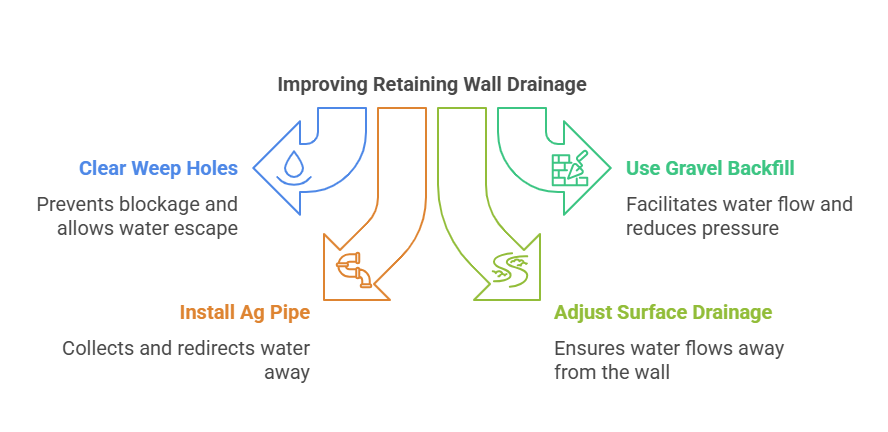
Good drainage is one of the most important factors in making sure your retaining wall lasts as long as possible. Without it, water builds up behind the wall, adding pressure that can cause cracks, bulging, or even a total collapse. Here are a few simple ways to improve or maintain drainage behind your wall:
- Clear existing weep holes regularly. These small openings allow water to escape, but they can get blocked by dirt, leaves, or debris over time.
- Use gravel backfill instead of just soil. Gravel allows water to flow freely behind the wall and reduces pressure build-up.
- Install a perforated ag pipe behind the base of the wall. This pipe collects and redirects water away from the structure, preventing it from pooling behind the wall.
- Make sure surface water drains away from the wall. Adjust landscaping or grading so that rainwater and runoff flow away, not toward the wall.
What Happens If I Ignore Retaining Wall Damage?
Leaving damage unchecked can turn small issues into major structural failures. Cracks can widen, bulging can get worse, and poor drainage can lead to a buildup of pressure behind the wall. Over time, this can cause the wall to lean, collapse, or even lead to erosion that affects the rest of your yard.
Ignoring the problem can also put you at risk of property damage or legal trouble. If a failing wall impacts your neighbour’s property or causes soil or water runoff onto their land, you could be held responsible for the repairs. The council may also issue fines or require urgent repairs if the wall is deemed unsafe. Staying on top of small fixes can help you avoid costly emergencies later on.
Can I DIY Retaining Wall Maintenance or Should I Hire a Professional?
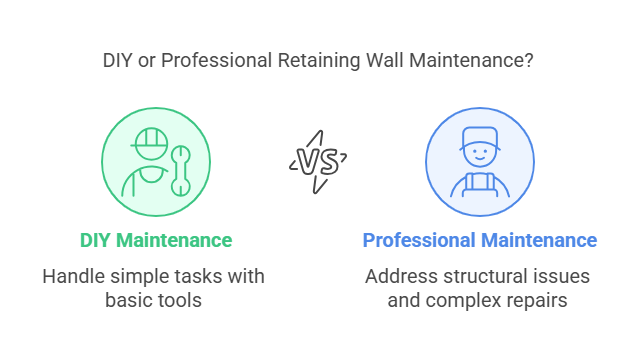
Some retaining wall maintenance tasks are simple enough for homeowners to handle. Things like clearing weep holes, checking for cracks, cleaning off stains, or even replacing a damaged timber sleeper can usually be done with basic tools and a bit of know-how. Staying on top of these small jobs helps prevent bigger issues from developing.
However, if you notice signs of structural damage such as leaning, bulging, widespread cracking, or poor drainage, it is best to call in a professional retaining wall specialist. A licensed contractor can assess the condition of the wall, recommend repairs, and ensure any work meets relevant standards. Structural repairs, drainage system upgrades, or full replacements should always be left to the experts to avoid safety risks and ensure long-term stability.
Keep Your Retaining Wall Standing Strong
Every retaining wall, no matter how sturdy, needs a little care to keep doing its job. Whether it’s timber, concrete, sandstone, or gabion, regular maintenance and good drainage can add years to its lifespan and help avoid costly repairs down the line. Keep an eye out for early warning signs like cracking, bulging, or poor drainage, and don’t wait too long to take action.
Not sure where to start? We’re a local Gold Coast retaining wall company, ready to help you out. Whether you need advice, a quick fix, or a full rebuild, we’re here to help you protect your property and keep your landscape looking its best. Contact us today for expert support and reliable service!




